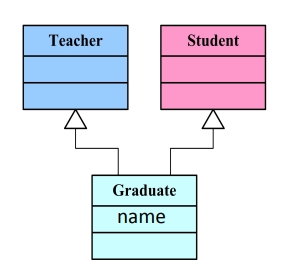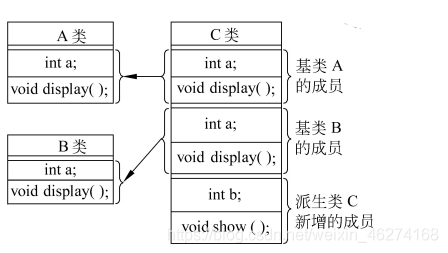C++多重继承 C/C++中多重继承详解及其作用介绍
我是小白呀 人气:0想了解C/C++中多重继承详解及其作用介绍的相关内容吗,我是小白呀在本文为您仔细讲解C++多重继承的相关知识和一些Code实例,欢迎阅读和指正,我们先划重点:C++多重继承,C++继承,下面大家一起来学习吧。
概述
多重继承 (multiple inheritance): 一个派生类有两个或多个基类, 派生类从两个或多个基类中继承所需的属性. C++ 为了适应这种情况, 允许一个派生类同时继承多个基类. 这种行为称为多重继承.

优缺点
优点
- 自然地做到了对单继承的扩展
- 可以继承多个类的功能
缺点
- 结构复杂化
- 优先顺序模糊
- 功能冲突
声明多重继承的方法
格式
多重继承的格式:
派生类构造函数名(总形式参数表列):
基类1构造函数(实际参数表列),
基类2构造函数(实际参数表列),
基类3构造函数(实际参数表列)
{
派生类中新增数成员据成员初始化语句
}
例子
Teacher 类:
#ifndef PROJECT5_TEACHER_H
#define PROJECT5_TEACHER_H
#include <string>
using namespace std;
class Teacher {
protected:
string name;
int age;
string title;
public:
Teacher(string n, int a, string t);
void display_teacher();
};
#endif //PROJECT5_TEACHER_H
Teacher.cpp:
#include <iostream>
#include "Teacher.h"
using namespace std;
Teacher::Teacher(string n, int a, string t) : name(n), age(a), title(t) {}
void Teacher::display_teacher() {
cout << "Teacher name: " << name << endl;
cout << "age: " << age << endl;
cout << "title: " << title << endl;
}
Student 类:
#ifndef PROJECT5_STUDENT_H
#define PROJECT5_STUDENT_H
#include <string>
using namespace std;
class Student {
protected:
string name;
char gender;
double score;
public:
Student(string n, char g, double s);
void display_student();
};
#endif //PROJECT5_STUDENT_H
Student.cpp:
#include <iostream>
#include "Student.h"
using namespace std;
Student::Student(string n, char g, double s) : name(n), gender(g), score(s) {}
void Student::display_student() {
cout << "Student name: " << name << endl;
cout << "gender: " << gender << endl;
cout << "score: " << score << endl;
}
Graduate 类:
#ifndef PROJECT5_GRADUATE_H
#define PROJECT5_GRADUATE_H
#include "Teacher.h"
#include "Student.h"
#include <string>
using namespace std;
class Graduate : public Teacher, public Student{
private:
double wage;
public:
Graduate(string t_n, int t_a, string t_t, string s_n, char s_g, double s_s);
void display_graduate();
};
#endif //PROJECT5_GRADUATE_H
Graduate.cpp:
#include "Graduate.h"
Graduate::Graduate(string t_n, int t_a, string t_t, string s_n, char s_g, double s_s) :
Teacher(t_n, t_a, t_t),
Student(s_n, s_g, s_s) {}
void Graduate::display_graduate() {
display_teacher();
display_student();
}
main:
#include <iostream>
#include "Graduate.h"
using namespace std;
int main() {
Graduate graduate1("王叔叔", 18, "隔壁老王", "我是小白呀", 'f', 99);
graduate1.display_graduate();
return 0;
}
输出结果:
Teacher name: 王叔叔 age: 18 title: 隔壁老王 Student name: 我是小白呀 gender: f score: 99
二义性
二义性 (Ambiguity) 指在多重继承中, 两个基类中的数据成员名相同.

二义性在派生类中的解决方法:
- 在标识符前用类名做前缀: Teacher::name 和 Student::name
- 基类和派生类需要有一个完整的设计, 不能随意而为
两个基类有同名成员

A 类:
#ifndef PROJECT5_A_H
#define PROJECT5_A_H
#include <iostream>
using namespace std;
class A {
public:
int num;
void display() {cout << "A's num:" << num << endl;};
};
#endif //PROJECT5_A_H
B 类:
#ifndef PROJECT5_B_H
#define PROJECT5_B_H
#include <iostream>
using namespace std;
class B {
public:
int num;
void display() {cout << "B's num:" << num << endl;};
};
#endif //PROJECT5_B_H
C 类:
#ifndef PROJECT5_C_H
#define PROJECT5_C_H
#include <iostream>
#include "A.h"
#include "B.h"
using namespace std;
class C: public A, public B{
public:
int c;
void display() {cout << c << endl;};
};
#endif //PROJECT5_C_H
main:
#include <iostream>
#include "C.h"
using namespace std;
int main() {
C c1;
c1.A::num = 1; // 用基类名限定
c1.B::num = 2; // 用基类名限定
c1.A::display();
c1.B::display();
return 0;
}
输出结果:
A's num:1 B's num:2
错误的写法
#include <iostream>
#include "C.h"
using namespace std;
int main() {
C c1;
c1.num = 1;
c1.display();
return 0;
}
基类和派生类有同名成员
A 类:
class A {
public:
int num;
void display() {cout << "A's num:" << num << endl;};
};
B 类:
class B {
public:
int num;
void display() {cout << "B's num:" << num << endl;};
};
C 类:
class C: public A, public B{
public:
int num;
void display() {cout << "C's num:" << num << endl;};
};
main:
int main() {
C c1;
c1.num = 3;
c1.A::num = 1;
c1.B::num = 2;
c1.display();
c1.A::display();
c1.B::display();
return 0;
}
输出结果:
C's num:3 A's num:1 B's num:2
同名覆盖:
- 基类的同名成员在派生类中被屏蔽, 成为 "不可见"的
- 对成员函数, 限于函数名和参数个数相同, 类型相匹配. 若只有函数名相同而参数不同, 属于函数重载
两个基类从同一个基类派生
N 类:
class N {
public:
int a;
void display(){
cout << "A::a=" << a <<endl;
}
};
A 类:
class A : public N {
public:
int a1;
};
B 类:
class B : public N {
public:
int a2;
};
C 类:
class C: public A, public B{
public:
int a3;
void display() {cout << "a3=" << a3 << endl;};
};
main:
int main() {
C c1;
// 合法访问
c1.A::a = 3;
c1.A::display();
return 0;
}
输出结果:
A::a=3
加载全部内容